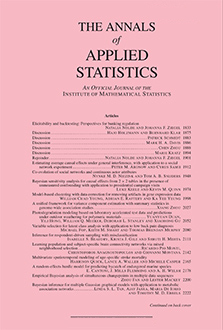Abstract
We consider the problem of estimating a common period for a set of functions sampled at irregular intervals. The motivating problem arises in astronomy, where the functions represent a star’s observed brightness over time through different photometric filters. While current methods perform well when the brightness is sampled densely enough in at least one filter, they break down when no brightness function is densely sampled. In this paper we introduce two new methods for period estimation in this important latter case. The first, multiband generalized Lomb–Scargle (MGLS), extends the frequently used Lomb–Scargle method to naïvely combine information across filters. The second, penalized generalized Lomb–Scargle (PGLS), builds on MGLS by more intelligently borrowing strength across filters. Specifically, we incorporate constraints on the phases and amplitudes across the different functions using a nonconvex penalized likelihood function. We develop a fast algorithm to optimize the penalized likelihood that combines block coordinate descent with the majorization–minimization (MM) principle. We test and validate our methods on synthetic and real astronomy data. Both PGLS and MGLS improve period estimation accuracy over current methods based on using a single function; moreover, PGLS outperforms MGLS and other leading methods when the functions are sparsely sampled.
Citation
James P. Long. Eric C. Chi. Richard G. Baraniuk. "Estimating a common period for a set of irregularly sampled functions with applications to periodic variable star data." Ann. Appl. Stat. 10 (1) 165 - 197, March 2016. https://doi.org/10.1214/15-AOAS885
Information





